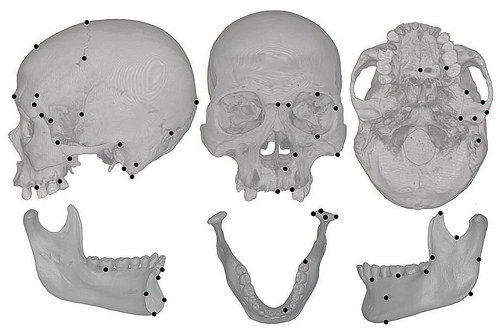
A study* indicates that the transition from foraging to farming was associated with modest but functionally relevant changes in the shape of the human skull. Previous studies indicate that the shape of the human skull changed with the emergence of agriculture, likely due to the increased availability of soft foods. However, determining the consistency and extent of changes in skull shape at a global scale has proven difficult. Based on a worldwide collection of 559 crania and 534 mandibles from more than two dozen preindustrial populations, David Katz and colleagues modeled the influence of diet on the shape, form, and size of the human skull during the transition to agriculture. The authors analyzed the importance of cereals and dairy, two common agricultural staples, and identified modest changes in skull morphology for groups that consumed cereals, dairy, or both cereals and dairy, supporting the hypothesis that the practice of chewing food decreased in farming populations. The largest changes in skull morphology were observed in groups consuming dairy, suggesting that the effect of agriculture on skull morphology was greatest in populations consuming the softest food. According to the authors, morphological differences due to diet tended to be small relative to other factors that contribute to human skull variation, such as differences between males and females or typical differences between individuals with the same diet but from different populations.
__________________________________________
Skull landmarks. Courtesy David C. Katz, et al.*
_______________________________
*“Changes in human skull morphology across the agricultural transition are consistent with softer diets in preindustrial farming groups,” by David C. Katz, Mark N. Grote, and Timothy D. Weaver. Available at http://www.pnas.org/cgi/doi/10.1073/pnas.1702586114
Human skull image, top left: Courtesy BernardBill5
_________________________________________
Receive 30 days free access to the popular new CuriosityStream lineup of documentaries on science, history, nature, and technology as a new Popular Archaeology premium subscriber.
___________________________________________
Travel and learn with Far Horizons.
____________________________________________
This richly illustrated issue includes the following stories: Recent findings shedding new light on the whereabouts of the remains of Philip of Macedon, father of Alexander the Great; how an archaeologist-sculptor is bringing bones of the dead back to life; archaeologists uncovering town life at the dawn of civilization; an exclusive interview with internationally acclaimed archaeologist James M. Adovasio about what makes the Meadowcroft Rockshelter prominent in the ongoing search for the first Americans; what archaeologists are finding at the site of the ancient city of Gath, the home town of the biblical Philistine giant, Goliath; and how scientists are redrawing the picture of human evolution in Europe. Find it on Amazon.com.








